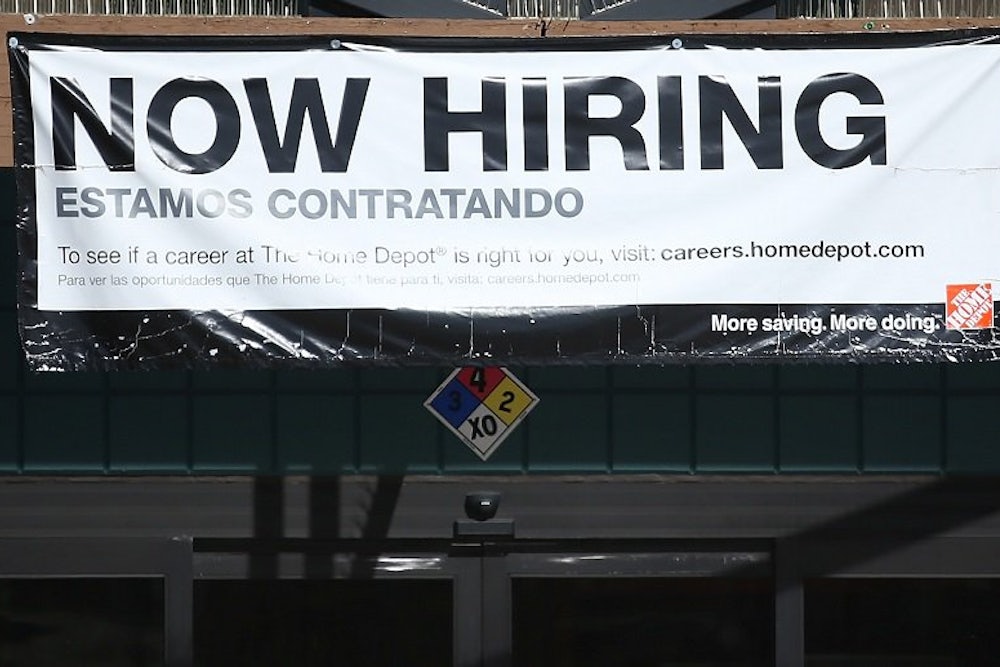On Friday morning, all eyes were on the Department of Labor as it released the jobs report February—and at first, there was a big problem: The clock struck 8:30 am and the Bureau of Labor Statistics website went down. Twitter, naturally, panicked.
But the delay didn’t last long. Moments later, BLS reported that the economy added 295,000 jobs last month, beating expectations of 225,000. The unemployment rate fell from 5.7 percent to 5.5 percent. As always, this one-month snapshot can be particularly noisy. It’s better to look at a three-month moving average, which clearly shows that the recovery has accelerated over the past four months:

There were no revisions to the December jobs report (329,000 jobs added) while January was revised down by 18,000 to 239,000. Those revisions confirm the strong growth in each of those months.
Yet, despite the strong topline numbers, the underlying details were disappointing. Wages, the key metric that economists are watching to determine the slack in the labor market, ticked up just 0.1 percent. Over the past year, they’ve grown 2 percent. Thanks to falling oil prices, which have lowered inflation, real wage growth is positive over the past year. But that’s still not a particularly strong number. Wages must grow at a 3 to 4 percent rate to keep up with both inflation and productivity growth. We’re still not close to that.
The labor force participation rate also ticked down slightly to 62.8 percent, from 62.9 percent. Since April 2014, the LFPR has stayed between 62.7 and 62.9 percent. That’s actually good news, in a sense. With baby boomers retiring, economists project the labor force to gradually decline in the coming years. The fact that it is holding steady means discouraged workers that exited the labor market after the financial crisis are reentering it as their job prospects pick up. Still, if all—or even many—of the currently discouraged workers reentered the labor market, the LFPR would rise considerably. That’s not happening.
The Federal Reserve is watching this jobs report very closely. The Federal Open Markets Committee (FOMC), which sets monetary policy, meets on March 17 and 18 and it will continue to discuss when to raise interest rates above zero for the first time since 2009. If the FOMC raises them too early, it could strangle the recovery before the vast majority of Americans actually see real wage growth. Raise them too late, however, and moderate inflation could follow. With inflation still muted and wage growth nowhere to be found, this new data should make the Fed more cautious about when it will raise rates.
There’s also a new debate brewing at the Fed over the unemployment rate. The Fed considers an unemployment rate between 5.2 and 5.5 percent representative of an economy at full employment. That number is known as the Non-Accelerating Inflation Rate of Unemployment—NAIRU, for short. The NAIRU is the Fed’s guess at what the unemployment rate should be to keep inflation stable. But few, if any, economists believe that we are at full employment right now, even though the unemployment rate fell to 5.5 percent. In fact, the drop in the unemployment rate in February was bad news because it was the result of people exiting the labor market.
The Fed isn’t blind to these developments. It is considering lowering the NAIRU from 5.2-5.5 percent. Expect to hear much more about this debate in the months ahead, particularly at the March FOMC meeting when Fed chair Janet Yellen will take questions from the press.
Most importantly for the Fed, it must stay focused on the data. Over the past month, we’ve heard anecdotal good news about the economy. Economic reporters were surprised when Wal-Mart announced that it was raising wages for all its employees. TJ Maxx quickly did so as well. This was clearly indicative, economic analysts noted, of a tightening labor market. Retailers had to lift wages to attract and keep their workers. Those analyses are correct. But the February jobs report is a reminder that anecdotal reports don’t tell the entire story: Wage growth across the economy still hasn’t improved. There's still not reason for the Fed to consider raising rates anytime soon.
